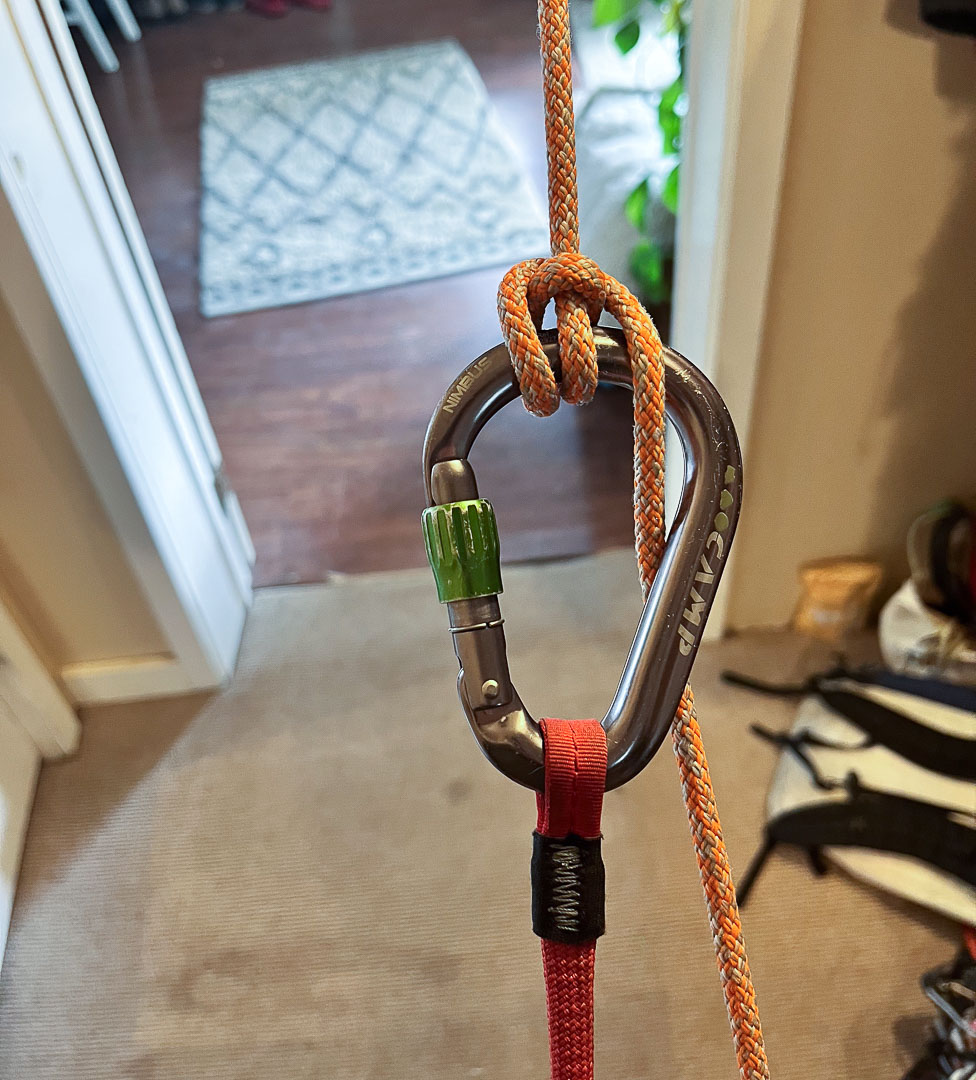We received a comment on Rappelling on Skinny Ropes—Part 1: Devices from a reader asking about using a Super Münter hitch to rappel on a skinny rope. Let’s break down some basics, and then get into a text thread between Billy Haas, Adam Fabrikant, and Gavin Hess.
The basic Münter hitch is a “hitch” clipped into (ideally) a specific carabiner (more on this later) that provides friction on the line/rope when either rappelling or belaying. The Münter hitch is useful as it is reversible—line can be fed in and out from the carabiner depending on the application. In short, understanding how to use a Münter pays dividends if you accidentally drop your dedicated belay/rappel device.
The downside of the Münter is the twisting introduced to the rope in either direction—belaying or rappelling. But again, in a dropped-device-scenario, a twisted rope is worth the cost of inadequate friction.
The Super Münter is an iteration of the Münter that essentially creates a Münter on top of (or stacked) on a Münter. In this case, the friction is increased substantially, and, in practice, twists the rope slightly less than a straight up Münter. This increased friction makes it a possible consideration for rappelling the skinny ropes discussed in the “Rappelling on skinny ropes” article and episode 1 of The High Route Gear Shed Podcast.
Here’s the disclaimer: you’ve got plenty of places on IG and the Interwebs to find tutorials on creating Münters and their hitch brethren, the Super Münter. So, we’ll pass on presenting that here. Climbing and ski-mountaineering are potentially dangerous; learn, practice, and practice more before applying anything discussed here in the field.
Here’s the original reader question: What are your thoughts on just rapping with a Super münter on skinny lines?
Thoughts from Adam, Billy, and Gavin
Billy: Yea, good question, I’ve tried it. A few quick thoughts. It totally works and is good to know and use in a pinch. I still prefer a small diameter specific belay device. A Super Münter adds more friction than a standard Münter, but with a really skinny rope (RAD line or Mammut Glacier Cord), we’re talking ~6mm in diameter, it still doesn’t seem to have the same braking control (smooth ride), especially when used with a 3rd hand backup (a friction hitch/autobloc).
The Super Münter “mostly” eliminates the Münter’s twisting issue, but not entirely.
This is important; considerations need to be made for the type of locking carabiner used. Smaller diameter lockers, especially carabiners that don’t have round stock, won’t have nearly as much friction as big HMS round stock carabiners.
Editor’s Note: HMS, short for “Halbmastwurfsicherung” in German, which means half clove hitch belay, and it’s designed with something like the Münter hitch in mind—the carabiners are pear shaped with a wide end that accommodates the hitch.
Billy: At that point, if I’m bringing a big HMS carabiner, the weight issue is probably negligible, and I can do more, better, with my lightweight locker and a skinny rope specific belay device, a Grivel Plume K3N and Petzl Reversino.
For me, it’s mostly preference. However, I should reiterate, the Super Münter is important to know—belay devices get dropped, and for single strands or skinny ropes, it’s the way to go if you don’t have a belay device.
Adam: I think there’s a large difference in holding power between the Münter and Super Münter. 200lb of holding power for the Münter compared to 1000lbs for the Super Münter?
Editor’s Note: Adam is very close. Ropelab.com.au states the following data for the Münter.
“We did some simple tests at RopeLab and found that if using a dry 11mm nylon rope in good condition on a large HMS carabiner then a single brake hand could easily control around 0.9kN in the forward position and 1.2kN in the maximum friction position. With a good stance and two hands on the brake rope these numbers increased to around 1.9kN and 3.4kN. Note that this was what could be held stationary, rather than what could be lowered in a controlled manner.”






Leave a Reply
You must be logged in to post a comment.